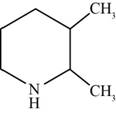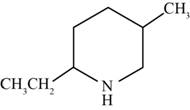
Concept explainers
Name the following:

(a)
Interpretation:
The given chemical structure has to be named.
Concept Introduction:
The nomenclature of the chemical structures:
A molecular formula describes the total number and types of the atoms in a molecule, whereas chemical structures describe the arrangement of atoms in a compound.
International Union of Pure and Applied Chemistry gave guidelines to write the chemical name of molecules. IUPAC names are totally different from common names because IUPAC names are applied at international level and it comprises suffix, prefix, numbers and other priority rules. The numbering starts from the side of substituent; if more than one substituent groups are present then these are cited alphabetically in the compound’s name.
Answer to Problem 21P
The name of the given compound is
Explanation of Solution
The structure of the given compound is shown below.

Figure 1
The compounds that comprise the saturated four membered rings are named as azetidines. The methyl substituent is present at the second carbon atom. Therefore, the name of the compound shown in figure is
(b)
Interpretation: The given chemical structure has to be named.
Concept Introduction:
The nomenclature of the chemical structures:
A molecular formula describes the total number and types of the atoms in a molecule, whereas chemical structures describe the arrangement of atoms in a compound.
International Union of Pure and Applied Chemistry gave guidelines to write the chemical name of molecules. IUPAC names are totally different from common names because IUPAC names are applied at international level and it comprises suffix, prefix, numbers and other priority rules. The numbering starts from the side of substituent; if more than one substituent groups are present then these are cited alphabetically in the compound’s name.
Answer to Problem 21P
The name of the given compound is
Explanation of Solution
The structure of the given compound is shown below.

Figure 2
The compounds that comprise the saturated six membered rings with a nitrogen atom are named as piperidines. The methyl substituents are present at the second and third carbon atoms. Therefore, the name of the compound shown in figure 2 is
(c)
Interpretation: The given chemical structure has to be named.
Concept Introduction:
The nomenclature of the chemical structures:
A molecular formula describes the total number and types of the atoms in a molecule, whereas chemical structures describe the arrangement of atoms in a compound.
International Union of Pure and Applied Chemistry gave guidelines to write the chemical name of molecules. IUPAC names are totally different from common names because IUPAC names are applied at international level and it comprises suffix, prefix, numbers and other priority rules. The numbering starts from the side of substituent; if more than one substituent groups are present then these are cited alphabetically in the compound’s name.
Answer to Problem 21P
The name of the given compound is
Explanation of Solution
The structure of the given compound is shown below.

Figure 3
The compounds that comprise the unsaturated four membered rings with a nitrogen atom are named as pyrroles. The chlorine substituent is present at the third carbon atom. Therefore, the name of the compound shown in figure 3 is
(d)
Interpretation:
The given chemical structure has to be named.
Concept Introduction:
The nomenclature of the chemical structures:
A molecular formula describes the total number and types of the atoms in a molecule, whereas chemical structures describe the arrangement of atoms in a compound.
International Union of Pure and Applied Chemistry gave guidelines to write the chemical name of molecules. IUPAC names are totally different from common names because IUPAC names are applied at international level and it comprises suffix, prefix, numbers and other priority rules. The numbering starts from the side of substituent; if more than one substituent groups are present then these are cited alphabetically in the compound’s name.
Answer to Problem 21P
The name of the given compound is
Explanation of Solution
The structure of the given compound is shown below.

Figure 4
The compounds that comprise saturated six membered rings with a nitrogen atom are named as piperidines. The ethyl and methyl substituents are present at the second and fifth carbon atoms respectively. Therefore, the name of the compound shown in figure is
Want to see more full solutions like this?
Chapter 20 Solutions
Organic Chemistry
- Give the IUPAC name for this compound Hydrocarbon Condensed Formulas Hint C2H5 CH2CH3 expand that in all the formula Part A: (CH3)2CHCH(C2H5)CH2CH2CH3 Give the IUPAC name for this compound. Part B: CH2=C(C2H5)CH2CH2CH3 Give the IUPAC name for this compound. Part C: (CH3)2C=CHC(C2H5)=CH2 Give the IUPAC name for this compound. Part D: CH3C=CCH(C2H5)2 Give the IUPAC name for this compound. Part E: (CH3)3CC=CCH2CH=C(CH3)2arrow_forwardSelect/ Match the correct letter from the image below for the IUPAC names given below: A B C D 3 E F G H K L Part 1. 4-methylheptane For example.mmmm Answer Letter H _for part 1 Part 2. 2,4-dimethylhexane Part 3. 2,3-dimethylpentane Part 4. 2,2-dimethylhexane Part 5. 2-ethyl-1,1,3,3-tetramethylcyclopentane Part 6. 3-ethyl-2-methylpentanearrow_forwardCan u show the process as to how to get these?arrow_forward
- Sketch the expected 'H NMR spectra for the following compound. Label all of the H's in the structure and the corresponding signal for the spectra you sketch. Make sure you include the integration value and the splitting pattern for each signal Indicate how many signals you would expect in the 13C NMRarrow_forwardUse IUPAC naming rules to name the following hydrocarbon compounds: CH2-CH3 | a) CH-CH-CH2-CH-CH-CH3 b) | CH2 CH3 | CH3 CH3 \ / C=C H 1 H CH2-CH3 c) d) CH=C-CH3 e) CH3-CH2-CH2-CH=CH-CH3 f) CH2=CH-CH2-CH=CH-CH3 g) CH3-CH2-C = C-CH2-CH3 h)arrow_forwardQ5 Name the following : a. b. C. d. e.arrow_forward
- 25. Predict the major product of the following reaction. 1 equivalent of each of the starting materials was used. H₂C CH3 CH3 H3C H3C H3C. CH2 + H3C. heat CH3 CH H.C. CH3 H.C H.C CH3 CH CH3 CH3 A B C Earrow_forwardFind chemical structures based on the below information. a) Chemical formula C6H8O Compound is aromatic plus has two 1H NMR peaks that integrated for 3 each that are singlets (it could have more peaks in the 1H NMR b) Chemical Formula: C6H100 Compounds is conjugated 'H NMR has a signal that integrates for 6 and is a doublet IR spectra has a signal at 1730 cm-1arrow_forwardJaslev Propose a synthesis of the following starting from benzene and any other reagents and chemicals. No mechanisms are required. Indicate the condition for each step plus the major product for each step. More than two steps are required. Step 1 Step 2 مہد Brarrow_forward
- Part C: The line formula for another branched alkane is shown below. i. In the IUPAC system what is the root or base name of this compound? ii. How many alkyl substituents are attached to the longest chain? iii. Give the IUPAC name for this compound.arrow_forwardPart D: Draw the Structural Formula for 4-ethyl-2-methylhexane Part E. Draw the Structural Formula for 1-chloro-3,3-diethylpentane (Chloro = Cl)arrow_forwardPart B: The line formula for a branched alkane is shown below. a. What is the molecular formula of this compound? Number of C. Number of H b. How many carbon atoms are in the longest chain? c. How many alkyl substituents are attached to this chain?arrow_forward

 Chemistry for Today: General, Organic, and Bioche...ChemistryISBN:9781305960060Author:Spencer L. Seager, Michael R. Slabaugh, Maren S. HansenPublisher:Cengage Learning
Chemistry for Today: General, Organic, and Bioche...ChemistryISBN:9781305960060Author:Spencer L. Seager, Michael R. Slabaugh, Maren S. HansenPublisher:Cengage Learning ChemistryChemistryISBN:9781305957404Author:Steven S. Zumdahl, Susan A. Zumdahl, Donald J. DeCostePublisher:Cengage Learning
ChemistryChemistryISBN:9781305957404Author:Steven S. Zumdahl, Susan A. Zumdahl, Donald J. DeCostePublisher:Cengage Learning Chemistry: An Atoms First ApproachChemistryISBN:9781305079243Author:Steven S. Zumdahl, Susan A. ZumdahlPublisher:Cengage Learning
Chemistry: An Atoms First ApproachChemistryISBN:9781305079243Author:Steven S. Zumdahl, Susan A. ZumdahlPublisher:Cengage Learning




